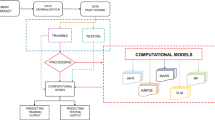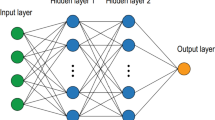Abstract
As a key mass transit system, railroad projects have recently taken on a significant role in urban mobility. Due to their relative importance, examining how stable these projects are in the face of traffic congestion, environmental hazards, and natural calamities is vital. A better understanding of soil response to dynamic loads, including liquefaction, can result in safer designs of railway structures that can reduce casualties. The phenomenon of liquefaction of fine soil deposits has become a recent inclination in the field of soil dynamics. Several factors affect the occurrence of soil liquefaction, including depth, fine content, plasticity, earthquake magnitude, and ground acceleration. The nonlinear and multiple influences amongst these parameters make their evaluation of liquefaction difficult. In this study, to predict the liquefaction response of railway embankment resting on fine-grained soil deposit enhanced machine learning (EML) model based on artificial neural networks (ANN), adaptive neuro-fuzzy inference system (ANFIS), and metaheuristic optimisation algorithm were used as an estimator. Machine learning techniques are very powerful mapping tools with a remarkable capacity to perform nonlinear multivariate function approximations. Ten EML models were examined, and the findings indicated that the developed models were highly accurate and precise at predicting the factor of safety against liquefaction (FS). With R2 values of 91% and 85% in the training and testing stages, the suggested ANFIS-FF model was the most successful in predicting the FS. The outcomes demonstrated that the ANFIS-based EML model is more reliable than existing models for predicting the development of liquefaction on a railway embankment on fine soil deposit and detecting the impact of different factors on dynamic soil behaviour.
















Similar content being viewed by others
References
Anitta Justin C and Sankar N 2022 Prediction of liquefaction of soils using particle swarm optimisation (PSO); In: International Conference on Structural Engineering and Construction Management, Springer Cham.
Armaghani D J and Asteris P G 2021 A comparative study of ANN and ANFIS models for the prediction of cement-based mortar materials compressive strength; Neural Comput. Appl. 33(9) 4501–4532.
Bardhan A and Samui P 2022 Probabilistic slope stability analysis of Heavy-haul freight corridor using a hybrid machine learning paradigm; Transp. Geotech. 37 100815.
Beyzaei C Z, Bray J D, Van Ballegooy S, Cubrinovski M and Bastin S 2018 Depositional environment effects on observed liquefaction performance in silt swamps during the Canterbury earthquake sequence; Soil Dyn. Earthq. Eng. 107 303–321.
Cabalar A F, Cevik A and Gokceoglu C 2012 Some applications of adaptive neuro-fuzzy inference system (ANFIS) in geotechnical engineering; Comput. Geotech. 40 14–33.
Demir S and Sahin E K 2023 Predicting occurrence of liquefaction-induced lateral spreading using gradient boosting algorithms integrated with particle swarm optimisation: PSO-XGBoost, PSO-LightGBM, and PSO-CatBoost; Acta Geotech., https://doi.org/10.1007/s11440-022-01777-11-17.
Esmaeili M and Noghabi H H 2013 Investigating seismic behavior of ballasted railway track in earthquake excitation using finite-element model in three-dimensional space; J. Transp. Eng. 139(7) 697–708.
Fang Y and Jairi N 2023 Neural and I transfer learning for soil liquefaction tests; Comput. Geosci. 171 105282.
Geng F, Yang W, Nadimi S, Han B and Huang G 2023 Study for predicting the earthquake-induced liquefaction around the monopile foundation of offshore wind turbines; Ocean Eng. 268 113421.
Ghani S and Kumari S 2021a Effect of plasticity index on liquefaction behavior of silty clay; In: Soil Dynamics, Springer Singapore, pp. 289–298.
Ghani S and Kumari S 2021b Insight into the effect of fine content on liquefaction behavior of soil; Geotech. Geol. Eng. 39(1) 1–12.
Ghani S and Kumari S 2021c Liquefaction study of fine-grained soil using computational model; Innov. Infrastruct. Solut. 6 58.
Ghani S and Kumari S 2021d Liquefaction susceptibility of high seismic region of Bihar considering fine content; In: Basics of Computational Geophysics, Elsevier, pp. 105–120.
Ghani S and Kumari S 2022a Liquefaction behavior of Indo-Gangetic region using novel metaheuristic optimisation algorithms coupled with artificial neural network; Nat. Hazards 111(3) 2995–3029.
Ghani S and Kumari S 2022b Liquefaction hazard mitigation using computational model considering sustainable development; In: Risk, reliability and sustainable remediation in the field of civil and environmental engineering, Elsevier, pp. 183–196.
Ghani S and Kumari S 2022c Reliability analysis for liquefaction risk assessment for the city of Patna, India using hybrid computational modeling; J. Geol. Soc. India 98(10) 1395–1406.
Ghani S and Kumari S 2023 January plasticity-based liquefaction prediction using support vector machine and adaptive Neuro-Fuzzy inference system; In: Soil dynamics, earthquake and computational geotechnical engineering; Proceedings of the Indian Geotechnical Conference 2021, Springer Nature Singapore, 5 515–527.
Ghani S, Kumari S and Bardhan A 2021 A novel liquefaction study for fine-grained soil using PCA-based hybrid soft computing models; Sādhanā 46(3) 1–17.
Ghani S, Kumari S and Ahmad S 2022a Prediction of the seismic effect on liquefaction behavior of fine-grained soils using artificial intelligence-based hybridized modeling; Arab. J. Sci. Eng. 47(4) 5411–5441.
Ghani S, Kumari S, Jaiswal S and Sawant V A 2022b Comparative and parametric study of AI-based models for risk assessment against soil liquefaction for high-intensity earthquakes; Arab. J. Geosci. 15(14) 1262.
Housner G W and Lili X 2002 Report on the great Tangshan earthquake of 1967; Chapter 1, 1–60.
Hwang J H and Yang C W 2001 Verification of critical cyclic strength curve by Taiwan Chi-Chi earthquake data; Soil Dyn. Earthq. Eng. 21(3) 237–257.
Jing G Q, Luo Q, Wang Z and Yin C 2014 Micro-analysis of lateral ballast resistance of seismic characteristics; J. Vibroengineering 16(1) 533–544.
Karaboga D 2005 An idea based on honey bee swarm for numerical optimisation; Erciyes University engineering faculty computer engineering department; Technical Report-tr06 200 1–10.
Kumar D R, Samui P and Burman A 2022a Determination of Best Criteria for Evaluation of Liquefaction Potential of Soil; Transp. Infrastruct. Geotechnol., pp. 1–20.
Kumar D R, Samui P and Burman A 2022b Prediction of probability of liquefaction using soft computing techniques; J. Inst. Eng. (India): Series A 103(4) 1195–1208.
Lai Z, Kang X, Jiang L, Zhou W, Feng Y, Zhang Y and Nie L 2020 Earthquake influence on the rail irregularity on high-speed railway bridge; Shock and Vibration, pp. 1–16.
Masoudi S, Sima M and Tolouei-Rad M A J I D 2018 Comparative study of ANN and ANFIS models for predicting temperature in machining; J. Eng. Sci. Technol. 13(1) 211–225.
Matsuo O, Shimazu T, Goto Y, Suzuki Y, Okumura R and Kuwabara M 1996 Deep mixing method as a liquefaction prevention measure; In: Proceedings of 2nd Int. Symp. On ground improvement geosystems, Tokyo, pp. 521–526.
Mijic Z, Bray J D, Riemer M F, Rees S D and Cubrinovski M 2021 Cyclic and monotonic simple shear testing of native Christchurch silty soil; Soil Dyn. Earthq. Eng. 148 106834.
Nakamura T, Sekine E and Shirae Y 2011 Assessment of aseismic performance of ballasted track with large-scale shaking table tests; Quarterly Report of RTRI 52(3) 156–162.
Rao R 2016 Review of applications of TLBO algorithm and a tutorial for beginners to solve the unconstrained and constrained optimisation problems; Decision Sci. Lett. 5(1) 1–30.
Ray R, Choudhary S S and Roy L B 2022 Reliability analysis of soil slope stability using MARS, GPR and FN soft computing techniques; Model. Earth Syst. Environ. 8(2) 2347–2357.
Sakamoto Y, Ishiguro M and Kitagawa G 1986 Akaike information criterion statistics; Dordrecht The Netherlands D. Reidel 81(10.5555) 26853.
Seed H B 1968 The fourth Terzaghi lecture: Landslides during earthquakes due to liquefaction; J. Soil Mech. Found. Div. 94(5) 1053–1122.
Seed H B and Idriss I M 1970 Analyses of ground motions at Union Bay, Seattle during earthquakes and distant nuclear blasts; Bull. Seismol. Soc. Am. 60(1) 125–136.
Sekine E and Ishikawa T 2005 Deformation characteristics of ballasted track during earthquake; RTRI Rep. Japan 19(2) 23–28.
Tabatabaei S A, Esmaeili M and Sadeghi J 2019 Investigation of the optimum height of railway embankments during earthquake based on their stability in liquefaction; J. Earthq. Eng. 23(5) 882–908.
Umar S K, Kumari S, Samui P and Kumar D 2022 A liquefaction study using ENN CA and biogeography optimised-based ANFIS Technique; Int. J. Appl. Metaheuristic Comput. (IJAMC) 13(1) 1–23.
Vrieze S I 2012 Model selection and psychological theory: A discussion of the differences between the Akaike information criterion (AIC) and the Bayesian information criterion (BIC); Psychol. Methods 17(2) 228.
Wang W S 1979 Some findings in soil liquefaction; Water Conservancy and Hydroelectric Power Scientific Research Institute.
Yang X S 2010 Firefly algorithm, stochastic test functions and design optimisation; arXiv preprint arXiv:1003.1409.
Yang X S and He X 2013 Firefly algorithm recent advances and applications; arXiv preprint arXiv:1308.3898.
Zhou J, Huang S, Zhou T, Armaghani D J and Qiu Y 2022 Employing a genetic algorithm and grey wolf optimiser for optimising RF models to evaluate soil liquefaction potential; Artif. Intell. Rev., pp. 1–33.
Author information
Authors and Affiliations
Contributions
SG: Conceptualisation, methodology, software, data curation, writing – original draft preparation, visualisation, investigation, validation. SK: Conceptualisation, supervision, writing – reviewing and editing.
Corresponding author
Additional information
Communicated by Sagarika Mukhopadhyay
Rights and permissions
About this article
Cite this article
Ghani, S., Kumari, S. Prediction of soil liquefaction for railway embankment resting on fine soil deposits using enhanced machine learning techniques. J Earth Syst Sci 132, 145 (2023). https://doi.org/10.1007/s12040-023-02156-4
Received:
Revised:
Accepted:
Published:
DOI: https://doi.org/10.1007/s12040-023-02156-4




